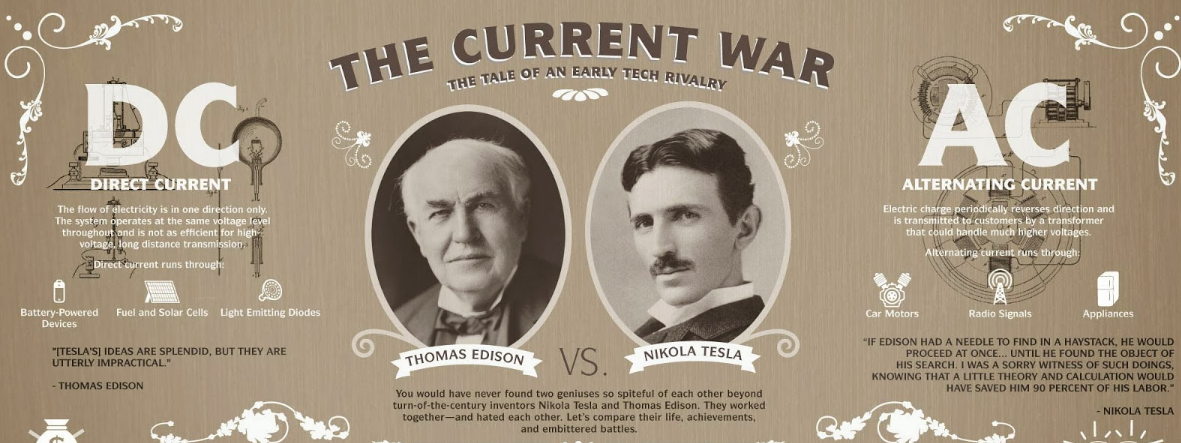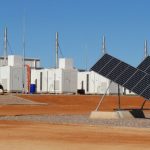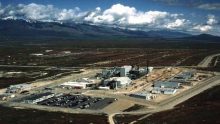
Universities, companies, and governments have been lining up for years to demonstrate the potential of DC microgrids, and the next generation of DC microgrid architectures are moving beyond demonstration projects to real world deployment on military bases, homes, industrial facilities. An influx of DC microgrids and distribution could be inevitable as solar panels, electric vehicles, batteries, LED lights, and DC electronics flood the electric grid, prompting innovators to seek more efficient ways of stringing them all together.
In addition to the high cost of inverters and transformers, a significant amount of energy is lost each time DC electricity is generated or consumed on an AC grid. It is not uncommon for current to switch back and forth multiple times.
Electricity may be generated on a roof (DC), converted to AC, brought back to DC to charge a car battery, converted back to AC to travel to a laptop cable which converts it back to usable DC electricity.
BENEFITS OF DC MICROGRIDS
- Lower energy losses
- 7-10% average higher utilization of on-site generation
- Higher reliability
- Resiliency during grid outages
- Emergency lighting support
- Lower investment
- Significant reduction in greenhouse gas emissions
Both AC and DC currents will coexist in the near future, but AC is starting to look like a 20th Century Cobweb as energy generation, storage, and loads are increasingly DC. The efficiency gained by connecting DC resources provides an enormous opportunity for microgrid developers, college campuses, communities, connected homes, and industrial facilities.
Anything with a battery is more efficient with DC energy, and we are heading towards a future just about everything will have a battery. Refrigerators, washing machines, and even individual lights can participate in demand response markets without sacrificing availability with relatively small batteries built in. These appliances will be able to ride through power outages or periods high grid prices.
Variable Frequency Drives (VFD) for Variable Renewable Energy (VRE)
Variable Frequency Drives, or VFDs are a gateway for AC motors and industrial loads to utilize DC resources like solar panels and batteries without dedicated inverters. Electric motors account for around 25% of the world’s electricity consumption. They are being adopted for energy efficiency but they can also be used to deal with fluctuations in renewable energy from wind and solar power.
DC microgrids can use VFDs to make any electric motor a flexible resource, enabling increased levels of renewable generation. As an example, DC energy from solar panels and batteries connected to electric motors with VFDs can desalinate seawater with 100% solar energy. Industrial loads can utilize VFDs to replace energy storage by using excess energy to produce industrial output, such as treated water.
DC electricity can also efficiently heat water. In fact, it may now more economical to use solar PV to heat water with DC heating elements (without converting to AC) than solar thermal water heaters, though solar thermal still uses less space. With simple controls, this use of DC energy can also increase DC Microgrid flexibility by storing excess energy as heat for when it’s needed.
DC Microgrid Demonstration Projects
Multiple universities, R&D labs, and companies are racing to unlock the efficiencies of DC microgrids. Here are some we’re following:
- ARDA Power is a global pioneer of DC Microgrid technology for non-residential buildings. Soon they will roll out the world’s 1st commercial plug-and-play microgrid solution to the market which will make it easy to design and construct a Microgrid in almost any building: on or off grid, with AC and DC loads, and powered by up to 100% renewables. A battery-centric, DC-connected platform conceived by ARDA engineers with technology originally developed at the University of Toronto makes possible microgrids that are simple, low cost, resilient and versatile. Leading a consortium of US based cleantech development firm, local utility and a German flow battery company, ARDA is commissioning Burlington DC Microgrid project in the headquarters and main manufacturing facility of Etratech in Burlington, Ontario in early 2017.
- Bosch is building out their supply chain for their DC Microgrid Architecture which will soon be demonstrated at a DC Microgrid at a Honda distribution plant in California. The building will operate on a 380-volt DC bus. Bosch plans to complete the project in February of 2018, where it will be tested and analyzed in a partnership with UC Davis. Bosch will use this project to demonstrate the feasibility and benefits of a commercial-scale DC building grid that integrates multiple advanced technologies to provide reliable power to the loads on the DC grid, resilience during grid outages, increased energy efficiencies and renewable energy utilization. Once the project is installed and commissioned, performance data will be collected to validate the cost savings, energy efficiency gains and the capabilities of the advanced microgrid energy management system.
- Moku o Lo’e (Coconut Island) DC Microgrid has deployed a DC microgrid on Coconut Island in collaboration with the University of Hawaii Manoa. The 500 KW island microgrid is owned by the island utility, and achieves high levels of renewable penetration. Critical loads at marine research facilities are met with DC distribution, motors, and lighting. The project seeks to demonstrate the value of DC distribution systems and microgrids.
- Kobe University’s Nushima Project demonstrates how DC microgrids improve system efficiency and resilience between 2012 and 2014. The project was successful and lead to an increased interest in DC Microgrids in Japan.
- Every watt counts for small, off-grid microgrids in developing countries. Many of the village-sized microgrids being deployed in Africa, India, and Bangladesh are less powerful than home solar systems in the United States. With no energy to waste, microgrids deployed by the SELCO Foundation in India don’t bother with AC. With DC solar panels, batteries, lights, and electronics sweeping the developing world, there’s little need for AC in rural electrification. The ultra-efficient appliances and DC architecture being developed there will ultimately make its way to the developed world.
- Allborg University (AAU), headed by Professor Josep Guerrero have launched an Intelligent DC Microgrid Living Lab in on campus in Allborg Denmark. The DC home laboratory “aims to demonstrate the viability of technical and cost advantages of using low voltage DC technology for supplying residential consumers in favor of traditional AC. This technology will enhance their power quality, reliability and also efficiency (up to 340% according to some U.S reports).”




